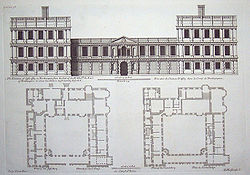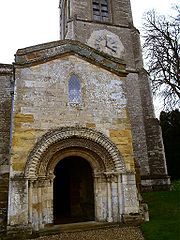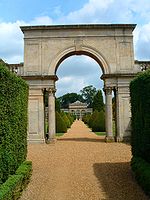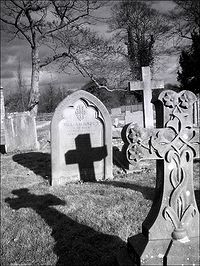
Castle Ashby Manor
Encyclopedia
Castle Ashby Manor was the seat of the Marquess of Northampton
. The castle
, a manor house
, was the result of a license obtained in 1306, for Langton, Bishop of Coventry
, to castellate his mansion in the village of Ashby. Sir Gerard Braybroke, Knt. was at one time of Castle Ashby Manor.
 The present rebuilding of Castle Ashby was started by Henry Compton, 1st Baron Compton
The present rebuilding of Castle Ashby was started by Henry Compton, 1st Baron Compton
, in 1574 and was continued by his son, created Earl of Northampton
. Queen Elizabeth I's first visit to the house was in 1600. Like other houses of its date, it was built in an E-shaped floorplan, a deep central porch and flight of steps forming the centre stroke of the E. This was to celebrate the coronation of Queen Elizabeth I. When King James
and his Queen
first stayed in 1605, the castle is documented as "Lord Compton's princely mansion", and in the household records we find that employed at this time were 83 household servants, four chaplains, three musicians and the Gardener of Ashby.
The parapet of stone lettering around the top of the house is dated 1624, and its Latin inscription runs as follows:
The words are based on the 127th Psalm
, "Except the Lord build the house they labour but in vain they who build it; except the Lord keep the house the watchman waketh but in vain".
By 1635 an ambitious classicising screen had been added across the open southern side of the courtyard, probably to make the two wings directly accessible to each another; its design deviates enough from Palladian canons to make it unlikely that Inigo Jones
designed it; Howard Colvin
suggested that a payment of £8 to "Cartor Surveyor" in the Earl's accounts, September 1631, may refer to Edward Carter, Jones's deputy at St. Paul's Cathedral, 1633-41. Work proceeded at Castle Ashby until, as Colen Campbell
the architect put it, "the Civil Wars
put a stop to all Arts".
 While the family was away fighting for the Royalist
While the family was away fighting for the Royalist
cause in the Civil War, the east side of the house was set on fire and severely damaged. The folklore is that an old woman known as Elspeth, who lived in the parvise
over the north porch of the church, first noticed the blaze and alerted the village, thus saving the remainder of the house. The marks of the flames can still be clearly seen on the lintels of the windows. The contents of the house were looted and much damage sustained to the estate by the Parliamentarians
.
In October 1695, King William III
visited the house and introduced the Dutch custom of planting avenues: not only to add to the importance of the house, but also to improve the outlook from its windows. Within a month of the visit, Lord Northampton began the planting of four avenues opposite each face of the house—something that took 25 years.
As a result of Capability Brown
's "return to nature" approach 35 years later, only two of these avenues now remain. Brown, the architect and landscape gardener, was called in during 1760. Apart from "altering" the avenues into small clumps of trees and doing away with the Elizabethan gardens, he enlarged the ponds overlooked by the house into ornamental lakes, dug a ha-ha
, or sunken fence, around the park and built the dairy and the temple against the menagerie. In 1771-74 the Great Hall was rebuilt for the 8th Earl by John Johnson
.
.jpg) It was not until the 1860s that any further substantial changes were carried out at the house, when Charles, the 3rd Marquess, and his wife brought in Sir Digby Wyatt, who made many changes to the interior of the house. Most of these were subsequently restored to their previous state by later generations who considered them ugly.
It was not until the 1860s that any further substantial changes were carried out at the house, when Charles, the 3rd Marquess, and his wife brought in Sir Digby Wyatt, who made many changes to the interior of the house. Most of these were subsequently restored to their previous state by later generations who considered them ugly.
At this time the terraces round the house with their terracotta balustrading were laid out, and the Italian "golden gates" at the entrance to the front drive were hung on piers designed by Wyatt himself. Sadly, before all the changes were carried out, Lady Northampton died of consumption, giving rise to the pitiful Latin inscription in terracotta lettering beside the church: "To Theodosia, sweetest of wives…Begun in hope, finished in regret."
 In 1867 the architect E.W. Godwin
In 1867 the architect E.W. Godwin
was called in to undertake further work; as a result, the Italianate Orangery and the Birmingham show houses were built to his designs. The old kitchen garden between them was also turned into an Italian garden with shaped beds divided by box edging, and the enormous kitchen garden beyond was walled in. Lodges were built approaching the station and at the entrance to the Avenue from the Northampton road. This latter pair, however, were pulled down in 1869, a year after their construction, for being too close together and were immediately rebuilt in their present position.
Later still, in the time of the 4th Marquess (1877–1897), extensive redecoration was carried out to the Long Gallery, Great Hall, Billiards Room and Chapel.

Marquess of Northampton
Marquess of Northampton is a title that has been created twice.-William Parr:First creation, 1547–1571The title was created for the first time in the Peerage of England in 1547 in favour of William Parr, brother of Catherine Parr, the sixth and last wife of King Henry VIII. The title was forfeited...
. The castle
Castle
A castle is a type of fortified structure built in Europe and the Middle East during the Middle Ages by European nobility. Scholars debate the scope of the word castle, but usually consider it to be the private fortified residence of a lord or noble...
, a manor house
Manor house
A manor house is a country house that historically formed the administrative centre of a manor, the lowest unit of territorial organisation in the feudal system in Europe. The term is applied to country houses that belonged to the gentry and other grand stately homes...
, was the result of a license obtained in 1306, for Langton, Bishop of Coventry
Bishop of Coventry
The Bishop of Coventry is the Ordinary of the England Diocese of Coventry in the Province of Canterbury. In the Middle Ages, the Bishop of Coventry was a title used by the bishops known today as the Bishop of Lichfield....
, to castellate his mansion in the village of Ashby. Sir Gerard Braybroke, Knt. was at one time of Castle Ashby Manor.
Architecture and fittings

Henry Compton, 1st Baron Compton
Henry Compton, 1st Baron Compton was an English peer.Compton was the son of Peter Compton and his wife Anne, daughter of George Talbot, 4th Earl of Shrewsbury, and a relative of Sir William Compton. In 1572 he was summoned to the House of Lords as Baron Compton, of Compton in the County of Warwick...
, in 1574 and was continued by his son, created Earl of Northampton
Earl of Northampton
Earl of Northampton is a title that has been created five times.-Earls in for the Honour of Huntingdon, first Creation :*Waltheof *Maud, Countess of Huntingdon** m. Simon I de Senlis** m...
. Queen Elizabeth I's first visit to the house was in 1600. Like other houses of its date, it was built in an E-shaped floorplan, a deep central porch and flight of steps forming the centre stroke of the E. This was to celebrate the coronation of Queen Elizabeth I. When King James
James I of England
James VI and I was King of Scots as James VI from 24 July 1567 and King of England and Ireland as James I from the union of the English and Scottish crowns on 24 March 1603...
and his Queen
Anne of Denmark
Anne of Denmark was queen consort of Scotland, England, and Ireland as the wife of King James VI and I.The second daughter of King Frederick II of Denmark, Anne married James in 1589 at the age of fourteen and bore him three children who survived infancy, including the future Charles I...
first stayed in 1605, the castle is documented as "Lord Compton's princely mansion", and in the household records we find that employed at this time were 83 household servants, four chaplains, three musicians and the Gardener of Ashby.
The parapet of stone lettering around the top of the house is dated 1624, and its Latin inscription runs as follows:
- NISI DOMINUS CUSTOS CUSTODIVERIT DOMUM FRUSTRA
- VIGILAT QUI CUSTODIT EAM: NISI DOMINUS AEDIFICAVERIT
- DOMUM IN VANUM LABORAVERUNT QUI AEDIFICANT EAM
The words are based on the 127th Psalm
Psalm 127
Psalm 127 is the 127th psalm from the Book of Psalms. It is one of 15 psalms that begins with the words "A song of ascents" .-Christianity:Musical settings include:...
, "Except the Lord build the house they labour but in vain they who build it; except the Lord keep the house the watchman waketh but in vain".
By 1635 an ambitious classicising screen had been added across the open southern side of the courtyard, probably to make the two wings directly accessible to each another; its design deviates enough from Palladian canons to make it unlikely that Inigo Jones
Inigo Jones
Inigo Jones is the first significant British architect of the modern period, and the first to bring Italianate Renaissance architecture to England...
designed it; Howard Colvin
Howard Colvin
Sir Howard Montagu Colvin, CVO, CBE , was a British architectural historian who produced two of the most outstanding works of scholarship in his field.-Life and works:...
suggested that a payment of £8 to "Cartor Surveyor" in the Earl's accounts, September 1631, may refer to Edward Carter, Jones's deputy at St. Paul's Cathedral, 1633-41. Work proceeded at Castle Ashby until, as Colen Campbell
Colen Campbell
Colen Campbell was a pioneering Scottish architect who spent most of his career in England, and is credited as a founder of the Georgian style...
the architect put it, "the Civil Wars
English Civil War
The English Civil War was a series of armed conflicts and political machinations between Parliamentarians and Royalists...
put a stop to all Arts".

Cavalier
Cavalier was the name used by Parliamentarians for a Royalist supporter of King Charles I and son Charles II during the English Civil War, the Interregnum, and the Restoration...
cause in the Civil War, the east side of the house was set on fire and severely damaged. The folklore is that an old woman known as Elspeth, who lived in the parvise
Parvise
Parvise or parvis may refer to:#A room over the porch of a church — quite often found in Norman churches in England. In some churches these rooms were used for school rooms and in Castle Ashby was the home of a woman - who saved the manor house from burning when she saw the fire taking hold from...
over the north porch of the church, first noticed the blaze and alerted the village, thus saving the remainder of the house. The marks of the flames can still be clearly seen on the lintels of the windows. The contents of the house were looted and much damage sustained to the estate by the Parliamentarians
Roundhead
"Roundhead" was the nickname given to the supporters of the Parliament during the English Civil War. Also known as Parliamentarians, they fought against King Charles I and his supporters, the Cavaliers , who claimed absolute power and the divine right of kings...
.
In October 1695, King William III
William III of England
William III & II was a sovereign Prince of Orange of the House of Orange-Nassau by birth. From 1672 he governed as Stadtholder William III of Orange over Holland, Zeeland, Utrecht, Guelders, and Overijssel of the Dutch Republic. From 1689 he reigned as William III over England and Ireland...
visited the house and introduced the Dutch custom of planting avenues: not only to add to the importance of the house, but also to improve the outlook from its windows. Within a month of the visit, Lord Northampton began the planting of four avenues opposite each face of the house—something that took 25 years.
As a result of Capability Brown
Capability Brown
Lancelot Brown , more commonly known as Capability Brown, was an English landscape architect. He is remembered as "the last of the great English eighteenth-century artists to be accorded his due", and "England's greatest gardener". He designed over 170 parks, many of which still endure...
's "return to nature" approach 35 years later, only two of these avenues now remain. Brown, the architect and landscape gardener, was called in during 1760. Apart from "altering" the avenues into small clumps of trees and doing away with the Elizabethan gardens, he enlarged the ponds overlooked by the house into ornamental lakes, dug a ha-ha
Ha-ha (garden)
Ha-ha is a term in garden design that refers to a trench, one side of which is concealed from view, designed to allow an unobstructed view from a garden, pleasure-ground, or park, while maintaining a physical barrier in one direction, usually to keep livestock out that are kept on an expansive...
, or sunken fence, around the park and built the dairy and the temple against the menagerie. In 1771-74 the Great Hall was rebuilt for the 8th Earl by John Johnson
John Johnson (architect)
John Johnson was an English architect and Surveyor to the County of Essex. He is best known for designing the Shire Hall, Chelmsford.-Life:...
.
.jpg)
At this time the terraces round the house with their terracotta balustrading were laid out, and the Italian "golden gates" at the entrance to the front drive were hung on piers designed by Wyatt himself. Sadly, before all the changes were carried out, Lady Northampton died of consumption, giving rise to the pitiful Latin inscription in terracotta lettering beside the church: "To Theodosia, sweetest of wives…Begun in hope, finished in regret."

Edward William Godwin
Edward William Godwin was a progressive English architect-designer, who began his career working in the strongly polychromatic "Ruskinian Gothic" style of mid-Victorian Britain, inspired by The Stones of Venice, then moved on to provide designs in the "Anglo-Japanese taste" of the Aesthetic...
was called in to undertake further work; as a result, the Italianate Orangery and the Birmingham show houses were built to his designs. The old kitchen garden between them was also turned into an Italian garden with shaped beds divided by box edging, and the enormous kitchen garden beyond was walled in. Lodges were built approaching the station and at the entrance to the Avenue from the Northampton road. This latter pair, however, were pulled down in 1869, a year after their construction, for being too close together and were immediately rebuilt in their present position.
Later still, in the time of the 4th Marquess (1877–1897), extensive redecoration was carried out to the Long Gallery, Great Hall, Billiards Room and Chapel.
Grounds

- The house today is the minor estate house—Compton WynyatesCompton WynyatesCompton Wynyates is a country house in Warwickshire, England, a Grade I listed building. The Tudor period house, an example of Tudor architecture, is constructed of red brick and built around a central courtyard. It is castellated and turreted in parts. Following action in the Civil War, half...
being the family's main residence; Castle Ashby is now used by the estate heir—currently the Earl Compton. - The Castle Ashby estate, now managed by Lord Compton, remains one of the area's great landowners; the estate includes land in many of the neighbouring villages, such as Grendon, DentonDenton, NorthamptonshireDenton is a small village and civil parish on the A428 Bedford road about south-east of Northampton. It has a pub, the Red Lion, a village hall, a Parish Church, St Margaret's, and a primary school....
and Yardley HastingsYardley HastingsYardley Hastings is a village in the English county of Northamptonshire. It is located south-east of the county town of Northampton and is skirted on its south side by the main A428 road to Bedford.-History:...
. - The estate grounds also include a fine cricket pitch in front of the castle and a mile-long drive.
- The grounds are open daily to the public. The house is not usually open but viewing can be on appointment.
- The grounds provided the venue for the GreenbeltGreenbelt festivalGreenbelt Festival is a festival of arts, faith and justice held annually in England since 1974. Greenbelt has grown from a Christian music festival with an audience of 1,500 young Christians to its current more secular festival attended by around 20,000 - Christians and non-Christians.The festival...
Christian music festival each year between 1984 and 1992. - Two open-air concerts were given by Sir Elton JohnElton JohnSir Elton Hercules John, CBE, Hon DMus is an English rock singer-songwriter, composer, pianist and occasional actor...
in the grounds in front of the house in July 2000. - Local amateur acting group The Parish Players, drawn from various of the nearby villages, holds regular performances in the castle—a tradition carried on now for some years.

